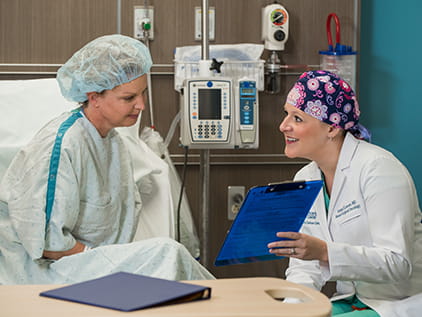- Home
- News Room
- Patient Stories Search Page
- Surviving Uterine and Ovarian Cancers
October 21, 2019
At age 32, Mandy Garavaglia and her husband, Johnny, hoped to conceive a second child through in vitro fertilization. A local reproductive clinic had helped the couple get pregnant with their daughter, Stella.
During the embryo implantation procedure in July 2015, polyps were found in Mandy’s uterus and removed. The pathology report indicated early-stage uterine cancer, also known as endometrial cancer.
Mandy, a hair stylist in Overland Park, asked her clients for advice on where to seek reproductive cancer treatment.
Conservative management
Mandy met with a gynecologic oncologist at The University of Kansas Cancer Center, who performed a pelvic exam, bloodwork and biopsy.
A small tissue biopsy was performed and confirmed the diagnosis of uterine cancer. A predisposition to a genetic mutation in 2 genes was also uncovered, so Mandy had genetic testing.”
The genetic results turned out to be good news for both Mandy and her daughter, Stella. Mandy does not carry hereditary markers that increase her risk for several types of cancer. She was negative for BRCA1 and BRCA2 mutations, as well as Lynch syndrome.
But the good news was followed by discouraging news.
“We had to put our fertility treatments and pregnancy plans on hold,” says Mandy.
Her gynecologic oncologist told her conception was out of the question until there was a complete reversal of her endometrial cancer. To treat the cancer, she placed a device in Mandy’s uterus that releases the hormone progesterone.
Ups and downs of endometrial cancer
By September 2016, Mandy showed no signs of endometrial cancer, so her doctor gave her the green light to pursue another pregnancy. She recommended regular checkups and a partial hysterectomy when Mandy felt her family was complete.
“I was hopeful we would conceive,” says Mandy.
But the couple’s dreams of a second child did not come to fruition. After 15 months without a pregnancy, Mandy decided it was time for surgery.
In January 2018, her doctor ordered a routine transvaginal ultrasound to make sure Mandy’s endometrial cancer was still in check. A similar test performed 6 months earlier showed no sign of recurrence.
This time, the scan revealed something different – a large mass on one of Mandy’s ovaries. It was not endometrial cancer.
“My doctor told me the best-case scenario was a cyst,” says Mandy. “Worst case, it was ovarian cancer. We wouldn’t know for sure until the day of surgery.”
The new surgery plan called for a zipper-size incision in Mandy’s abdomen. The affected ovary would be removed and sent to the pathology lab. If the tumor was cancerous, the incision would extend up to the breastbone, involve a full hysterectomy, and a search for cancer in other organs and lymph nodes.
When Mandy went in for surgery, she didn’t know if she would wake up with a scar that was small or large; with a diagnosis of cancer or no malignancy.
“Johnny came in after surgery with tears in his eyes and told me it was cancer,” says Mandy. “That was the darkest time, because I thought I was going to die.”
Early ovarian cancer detection
More than 15,000 women die of ovarian cancer each year, making it the 5th leading cause of death among American women. Only 20% of ovarian cancers are discovered early. Mandy was lucky to catch hers at stage 1C, when it was still confined to the ovaries and had not spread to distant sites.
It was serendipity, according to her doctor, who says during the search for endometrial cancer they discovered ovarian cancer that had not spread to her other organs or lymph nodes.
At present, there are no reliable screening tests for ovarian cancer.
“It’s frustrating,” says Mandy. “Cancers are treatable if you find them early. Sadly, ovarian cancer is hard to find.”
Ovarian cancer tumor type
Two weeks after surgery, Mandy met with her doctor to hear the pathology results. The initial lab work indicated a high-grade serous carcinoma, the most malignant form of ovarian cancer. This type of ovarian cancer accounts for up to 70% of all cases.
“Not the type of tumor you want to have,” says Mandy.
After more study, the pathologist called her doctor with new information. Mandy had a rare type of ovarian cancer called endometrioid. This low-grade cancer comes with better outcomes.
Mandy's doctor called her at home on a Saturday. “She told me my diagnosis had changed for the better!” Mandy says.
Mandy's doctor and her colleagues on the cancer center’s tumor board recommended 6 rounds of chemotherapy for Mandy. After 4 rounds, her white blood cell levels were so low, treatment was discontinued.
Fortunately, 4 rounds did the trick. In May 2018, Mandy learned she was cancer-free. She will continue taking an estrogen-blocking medication for up to 5 years.
Mandy has an excellent prognosis, according to her doctor, who says with continued monitoring she will do well.
Mind over matter
Today, Mandy is back at work in her hair studio where she visits with as many as 10 women a day. She’s become a cancer-screening evangelist, encouraging clients to pay attention to their bodies.
“Get your mammograms and well-woman checkups,” she advises. “Know your risk factors. And tell your doctor about symptoms.”
Mandy was aggressive in her battle with infertility and 2 reproductive cancers. Now, she’s positive about sharing a long life with Johnny and Stella.
“I feel good,” says Mandy. “My joints hurt some and I get tired easily. But I’ll take this over cancer any day.”

Your best option for beating cancer
The Women’s Cancer Center at The University of Kansas Cancer Center focuses on breast and gynecologic cancers, providing specialized care to women.
As with all treatments, individual patient results vary. It is important to discuss your treatment options with your healthcare provider.
